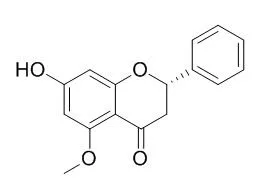| In vitro: |
| Immunopharmacol Immunotoxicol. 2014 Aug;36(4):290-6. | | Immunosuppressive activity of alpinetin on activation and cytokines secretion of murine T lymphocytes.[Pubmed: 24964870] | Alpinetin, a flavonoid compound extracted from the seeds of Alpinia katsumadai Hayata, has been known to possess antibacterial, anti-inflammatory and other important therapeutic activities.
METHODS AND RESULTS:
In the current study, we investigated Alpinetin for its immunosuppressive effect on activation and cytokines secretion of murine T lymphocytes. The data showed that Alpinetin markedly suppressed ConA-induced murine splenocyte proliferation, Th1/Th2 cytokines production, CD4(+) T-cell populations and ratio of CD4(+)/CD8(+). This inspired us to further study the effects of Alpinetin in vivo. The results showed that administration of Alpinetin suppressed T-cell-mediated delayed-type hypersensitivity reaction in mice. In addition, we studied signal transduction pathways about T-cell activation on puried murine T lymphocytes by Western-blot assay. The data revealed that Alpinetin could shock the activation of NF-κB, NFAT2 signal transduction pathways.
CONCLUSIONS:
These observations indicated that Alpinetin have potential effects in downregulating the immune system and might be developed as a useful immunosuppressive agent in treating undesired immune responses. | | Int J Mol Med. 2012 Apr;29(4):607-12. | | Antiproliferative effect of alpinetin in BxPC-3 pancreatic cancer cells.[Pubmed: 22246103 ] | Alpinetin is a novel plant flavonoid derived from Alpinia katsumadai Hayata, found to possess strong anticancer effects. However, the antitumor effect of Alpinetin on pancreatic cancer cells and the detailed mechanism remain unclear. The aim of this study was to investigate Alpinetin's beneficial effect on pancreatic cancer and the possible molecular mechanism involved.
METHODS AND RESULTS:
Pancreatic cancer cell lines were treated with Alpinetin at various doses and for different times, and the effect of Alpinetin on cell growth inhibition, apoptosis and the cell cycle was determined. The expression of Bcl-2, Bcl-xL, XIAP and Bax, the activity of caspases and the levels of cytochrome c released were measured. The results showed that Alpinetin inhibited the viability of three pancreatic cancer cell lines and induced apoptosis of BxPC-3 cells in a dose- and time-dependent manner. This was accompanied by regulation of the expression of Bcl-2, Bcl-xL, Bax and XIAP. Furthermore, Alpinetin treatment led to the release of cytochrome c and activation of caspases-3, -8 and -9 proteins.
CONCLUSIONS:
Taken together, our studies indicate that Alpinetin inhibited the proliferation of pancreatic cancer cells possibly through the regulation of the Bcl-2 family and XIAP expression, release of cytochrome c and the activation of caspases. Alpinetin may serve as a potential agent for the development of pancreatic cancer cell therapies. | | J Cardiovasc Pharmacol. 2001 May;37(5):596-606. | | Vasorelaxant effects of cardamonin and alpinetin from Alpinia henryi K. Schum.[Pubmed: 11336110] | The vascular effects of cardamonin and Alpinetin from Alpinia henryi K. Schum. were examined in the rat isolated mesenteric arteries.
METHODS AND RESULTS:
1H and 13C nuclear magnetic resonance spectra showed that cardamonin is present in trans-form, and single-crystal radiographic structure revealed that Alpinetin is present in S configuration. Both cardamonin and Alpinetin produced a rightward shift in the concentration-response curve for phenylephrine in a noncompetitive manner, and they induced relaxation of phenylephrine-preconstricted arteries with respective mean inhibitory concentrations (IC50) of 9.3+/-0.6 microM and 27.5+/-2.8 microM. Both compounds also relaxed arteries preconstricted by endothelin I or U46619. Their relaxant effects were decreased in endothelium-removed rings. Pretreatment with N(G)-nitro-L-arginine methyl ester or methylene blue inhibited relaxation induced by both agents, and pretreatment with L-arginine reversed the effect of N(G)-nitro-L-arginine methyl ester on cardamonin-induced endothelium-dependent relaxation. The relaxant effects of cardamonin and Alpinetin were unaffected by indomethacin (3 microM). Cardamonin and Alpinetin inhibited 60 mM K+-induced contraction with respective IC50 of 11.5+/-0.3 microM and 37.9+/-3.6 microM. In addition, both agents inhibited the transient contraction induced by 3 microM phenylephrine or by 10 mM caffeine in Ca2+-free Krebs solution. Finally, these two agents also concentration dependently relax the arteries preconstricted by 1 microM phorbol 12,13-diacetate in Ca2+-free Krebs solution.
CONCLUSIONS:
These results indicate that purified cardamonin and Alpinetin from A. henryi K. Schum. relaxed rat mesenteric arteries through multiple mechanisms. They induced both endothelium-dependent and -independent relaxation; the former is likely mediated by nitric oxide whereas the latter is probably mediated through nonselective inhibition of Ca2+ influx and intracellular Ca2+ release and inhibition of the protein kinase C-dependent contractile mechanism. |
|
| In vivo: |
| Int Immunopharmacol. 2015 Oct;28(2):1003-8. | | Alpinetin inhibits lipopolysaccharide-induced acute kidney injury in mice.[Pubmed: 26321118] | Alpinetin, a novel plant flavonoid isolated from Alpinia katsumadai Hayata, has been demonstrated to have anti-inflammatory and antioxidant effects. However, the effects of Alpinetin on lipopolysaccharide (LPS)-induced acute kidney injury have not been reported.
METHODS AND RESULTS:
In the present study, we investigated the protective effects and the underlying mechanism of Alpinetin against LPS-induced acute kidney injury in mice. The results showed that Alpinetin inhibited LPS-induced kidney histopathologic changes, blood urea nitrogen (BUN) and creatinine levels. Alpinetin also inhibited LPS-induced ROS, MDA, and inflammatory cytokines TNF-α, IL-6 and IL-1β production in kidney tissues. Meanwhile, Western blot analysis showed that Alpinetin suppressed LPS-induced TLR4 expression and NF-κB activation in kidney tissues. In addition, Alpinetin was found to up-regulate the expression of Nrf2 and HO-1 in a dose-dependent manner.
CONCLUSIONS:
In conclusion, Alpinetin protected LPS-induced kidney injury through activating Nrf2 and inhibiting TLR4 expression. |
|






 Cell. 2018 Jan 11;172(1-2):249-261.e12. doi: 10.1016/j.cell.2017.12.019.IF=36.216(2019)
Cell. 2018 Jan 11;172(1-2):249-261.e12. doi: 10.1016/j.cell.2017.12.019.IF=36.216(2019) Cell Metab. 2020 Mar 3;31(3):534-548.e5. doi: 10.1016/j.cmet.2020.01.002.IF=22.415(2019)
Cell Metab. 2020 Mar 3;31(3):534-548.e5. doi: 10.1016/j.cmet.2020.01.002.IF=22.415(2019) Mol Cell. 2017 Nov 16;68(4):673-685.e6. doi: 10.1016/j.molcel.2017.10.022.IF=14.548(2019)
Mol Cell. 2017 Nov 16;68(4):673-685.e6. doi: 10.1016/j.molcel.2017.10.022.IF=14.548(2019)